These Mojo Steak Arepas with Salsa Criolla are packed with flavor and are bound to be a hit at your upcoming cookout. The Mojo marinade, with its zesty and garlicky notes, serves as a fantastic way to tenderize and infuse less expensive cuts of steak, like flap, skirt, flank, and top sirloin, with rich flavors. When combined with a mouthwatering Salsa Criolla and wrapped in a warm arepa, it creates a culinary experience that’s simply divine!
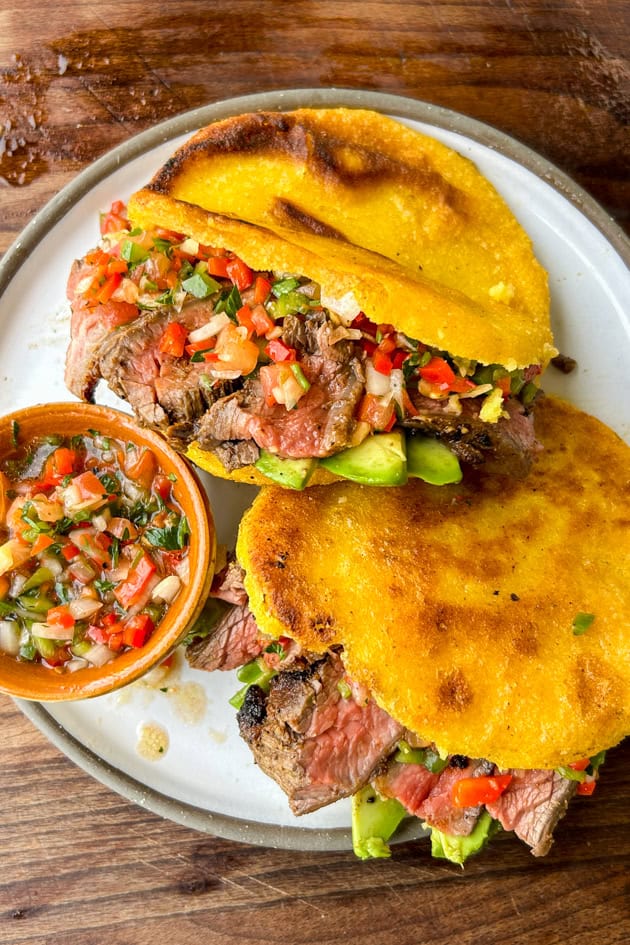
Essential Ingredients for Mojo Steak
- Steak: I opted for flap steak (also known as bavette) for this dish. It boasts a delightful beefy taste and cooks similarly to skirt steak. Typically, it is more budget-friendly and thicker than skirt steak, making it easier to achieve a perfectly medium-rare interior. It absorbs the mojo marinade wonderfully, resulting in a tender bite when cooked to medium-rare. Like skirt and flank steak, be sure to slice flap steak against the grain to avoid tough, chewy bits in each serving.
If flap steak is unavailable, you can substitute it with skirt, flank, top sirloin, tri-tip, or hanger steak. I advise against using pricier cuts like ribeye or NY strip, as they tend to be tender enough on their own and don’t require marinating.
- Naranja Agria: Sour orange juice (naranja agria) is indispensable in any Cuban-style mojo marinade, imparting a distinctively citrusy, tart, and bitter taste that is truly unmatched. While it may be hard to find fresh, I recommend avoiding jarred naranja agria juices that are made from concentrates and loaded with additives. Instead, combine 1 part orange juice with 2 parts lime juice. For an added layer of bitterness, consider incorporating 1 part grapefruit juice.
- Garlic: As always, trust your instinct with this ingredient; no one can ever use too much garlic!
- Spices: A blend of ground cumin, ground coriander, and bay leaves enhances the flavor profile of your mojo steak arepas. Don’t forget to generously season with kosher salt and freshly cracked black pepper.
- Avocado Oil: A neutral-flavored oil with a high smoke point is perfect for grilling or searing the steak in a hot cast-iron skillet.
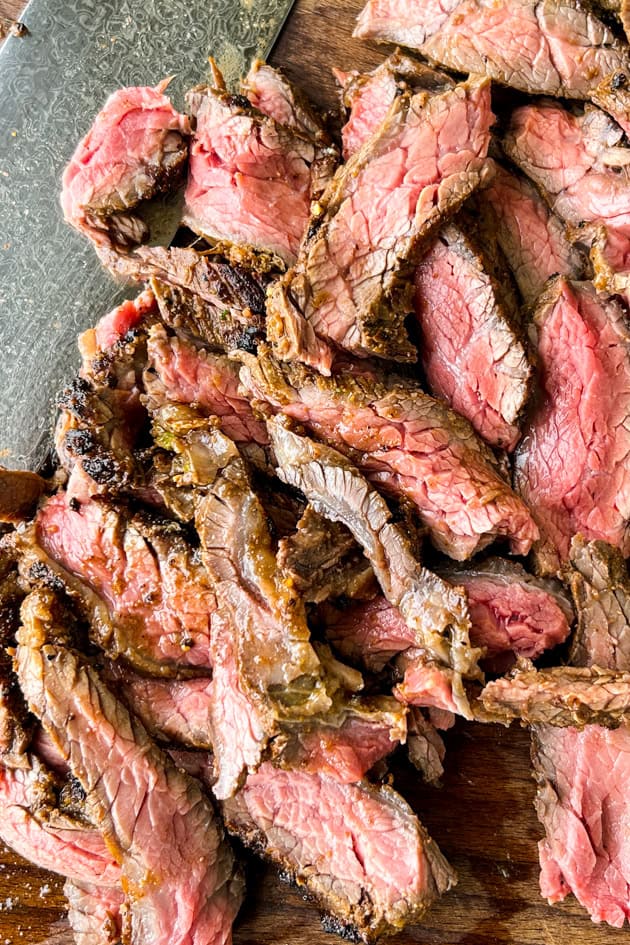
Ingredients Needed for Salsa Criolla
- Bell Peppers: A mix of finely diced green and red bell peppers contributes color, sweetness, and a delightful crunch to the salsa criolla.
- Tomato: To bring juiciness, acidity, and texture, include diced tomato. Opt for a firm tomato to ensure it retains its shape in the salsa.
- Onion: I prefer sweet, white onion for this salsa as it complements the bitter and sour elements of the mojo steak. Red onions can also work, offering a sharper flavor and additional color.
- Parsley: Finely chopped fresh parsley contributes a burst of color and brightens the salsa criolla—perfect for those averse to cilantro.
- Oil and Vinegar: Utilize high-quality extra-virgin olive oil and red wine vinegar, as the salsa’s flavor is quite delicate.
- Salt and Pepper: Season according to taste with kosher salt and freshly cracked black pepper.
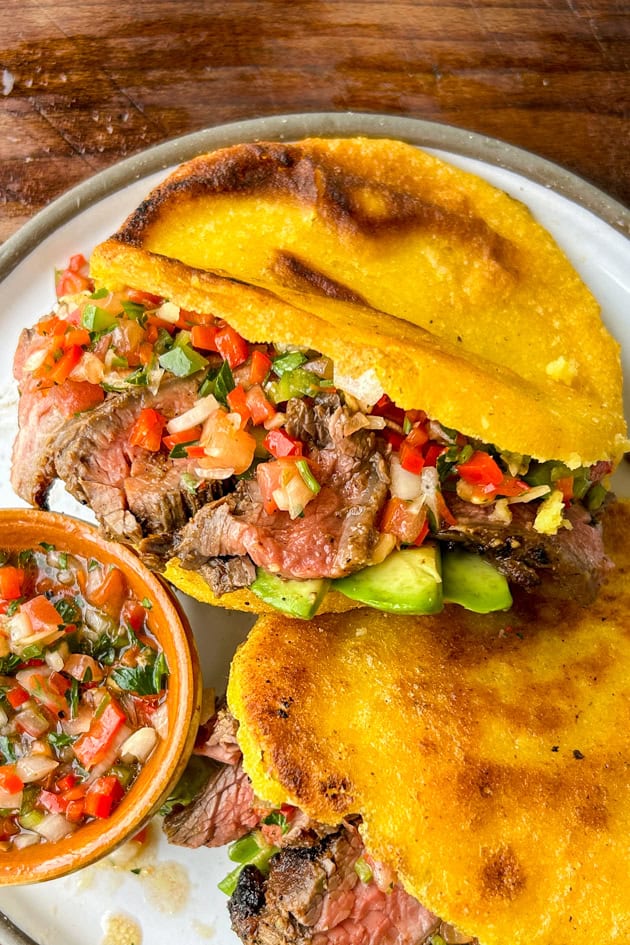
What Are Arepas?
Arepas are a beloved staple similar to flatbread, made from pre-cooked cornmeal, and are especially popular in Venezuela and Colombia. They can be grilled, baked, fried, or boiled. Typically, arepas are sliced open and filled with a range of ingredients, including cheese, shredded meat, chicken, beans, eggs, or avocado.
When preparing arepas, it’s crucial to use the right type of cornmeal. Look for fine-ground, pre-cooked masarepa. Doñarepa and P. A. N. are two of the most common brands found in North America. The flour is typically labeled masarepa, which shouldn’t be confused with masa harina—the flour used for tortillas. Masarepa is available in both white and yellow cornflour varieties, giving the arepas distinct colors and slightly different flavor profiles.
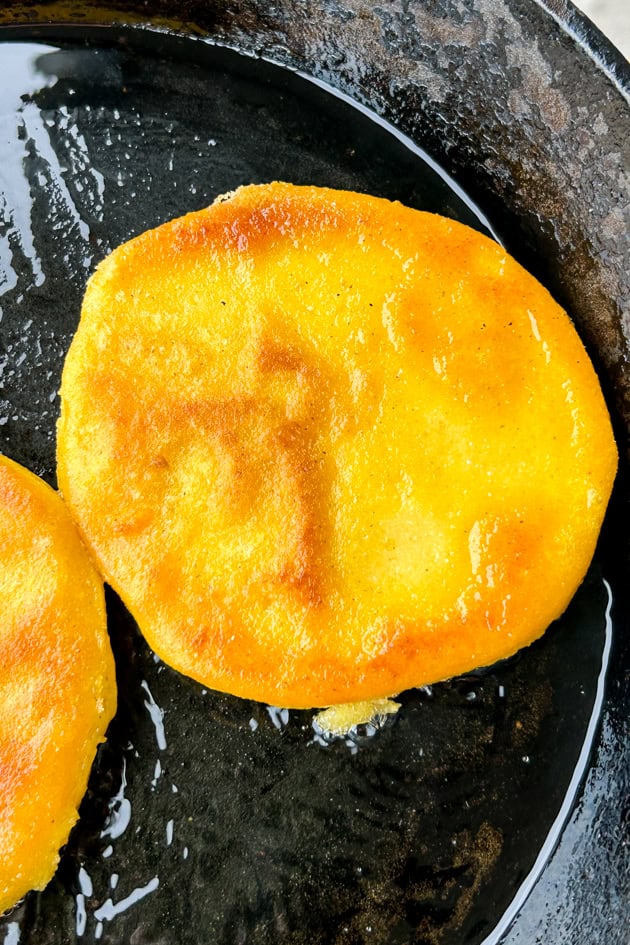
What is Salsa Criolla?
Salsa Criolla is a refreshing and simple condiment commonly served alongside grilled meats in Argentina. This salsa typically includes diced bell peppers, tomato, onion, parsley, oil, vinegar, salt, and pepper. Some variations may incorporate dried oregano or use lime juice instead of vinegar for acidity. Family recipes may vary widely. In Brazil, a very similar sauce is called Vinaigrette; however, it shouldn’t be confused with Peruvian Salsa Criolla, which mainly consists of thinly sliced onions.
How Long Should I Marinate the Steak?
You can marinate the steak for as little as 1 hour, but for optimal results, let it sit in the mojo marinade for up to 6 hours in the fridge. This allows the marinade enough time to enhance the meat’s flavor and aid in tenderization. You’ll be rewarded with juicy, flavorful mojo steak arepas.
Unless you’re using a very thick steak cut like a whole picanha roast (which is a top sirloin with the fat cap intact), it’s best not to marinate for more than 6 hours. The acid can start breaking down the muscle fibers, leading to a spongy texture.
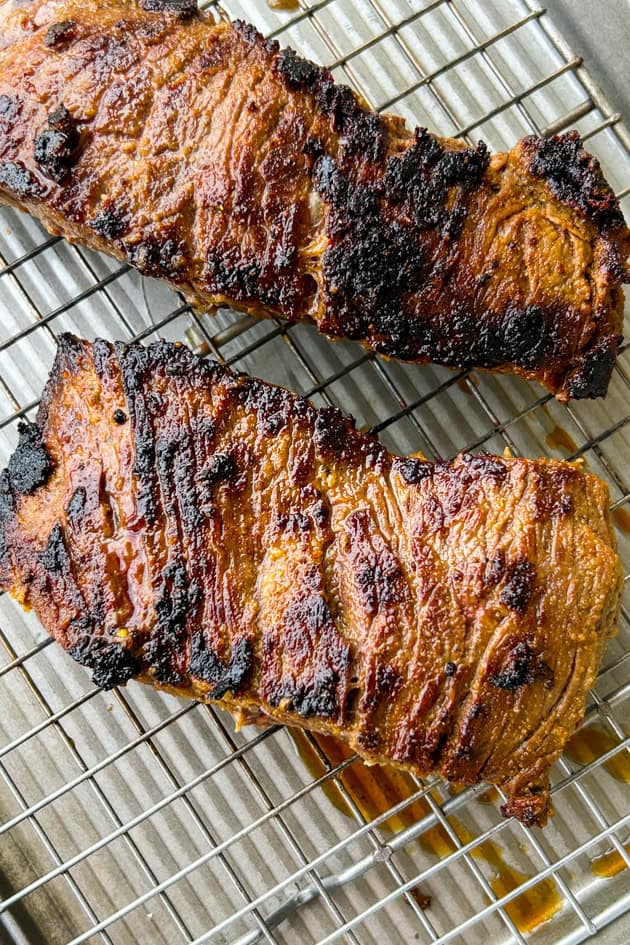
What is Naranja Agria?
Naranja agria, known as sour orange or bitter orange, is a citrus fruit extensively used in Latin American and Caribbean cuisine. This fruit resembles a small orange with rough, bumpy skin that can range in color from green to orange.
Unlike sweet oranges, naranja agria offers a tangy, slightly bitter flavor with high acidity, making it ideal for marinades. Its juice not only delivers a wonderful citrus taste but also helps tenderize tougher cuts of meat.
Naranja agria plays a vital role in Cuban-style Mojo marinades and Mexican Cochinita Pibil.
Naranja Agria Substitute
If naranja agria is hard to find, a combination of 1 part orange juice to 2 parts lime juice can replicate its sweet and acidic balance. For a hint of that characteristic bitterness, mix in 1 part grapefruit juice as well.
For the Mojo Steak:
-
In a bowl, mix the steak, naranja agria juice, avocado oil, garlic, bay leaves, cumin, coriander, salt, and pepper. Ensure everything is well-coated, then cover and refrigerate for 1 to 6 hours.
-
Preheat a grill or cast-iron skillet to medium-high heat. For grilling (475F for Traeger), cook the steak over direct heat until nice grill marks appear on both sides and the thickest part reads 125F. For skillet cooking, add 2 tablespoons of avocado oil, heating until it shimmers. Carefully place the steak in the pan and cook until lightly charred, about 4 minutes, then flip and cook the other side until charred and the thickest part registers 125F (approximately another 4 minutes, depending on the steak’s thickness and your cooktop’s heat).
-
Transfer the steak to a carving board and let it rest for at least 5 minutes before thinly slicing against the grain. Serve with salsa criolla, avocado, and arepas.
For the Salsa Criolla:
-
In a bowl, combine red pepper, green pepper, onion, tomato, parsley, olive oil, vinegar, salt, and pepper. Mix until everything is well combined, taste, and adjust the seasoning as necessary. Cover and set at room temperature until ready to serve. If making more than an hour in advance, cover and refrigerate for up to 24 hours and remove from the fridge 15 minutes before serving.
For the Arepas:
-
In a large mixing bowl, stir together water and salt until dissolved. Gradually add the masarepa while stirring with a spoon until a dough forms without lumps. The dough should be dry enough not to stick to your hands but tacky enough that it doesn’t crack at the edges when flattened. Adjust with more masarepa or water as necessary.
-
Shape the dough into a large ball, return it to the bowl, cover with a damp towel, and let rest for 10 minutes to hydrate.
-
Divide the dough into 4 equal portions for large arepas and roll them into balls. Use your palms to gently flatten them into discs about ¾ inches thick.
-
Prepare a plate lined with a kitchen towel. Add half of the avocado oil to a large cast-iron or non-stick skillet and heat over medium heat until shimmering. In batches, add the arepas to the hot oil and fry until golden brown, about 4 minutes. Flip and cook the second side until golden brown, about another 4 minutes. Add oil as needed. Place the cooked arepas on the prepared towel-lined plate while you fry the remaining ones. If you make them in advance, you can reheat them in a 350F oven for about 10 minutes.
-
To assemble, use a sharp paring knife to make a horizontal slit in half of each arepa, creating a pocket. Fill each pocket with sliced mojo steak, avocado, and salsa criolla, then serve.
Calories: 894kcal, Carbohydrates: 57g, Protein: 45g, Fat: 57g, Saturated Fat: 10g, Polyunsaturated Fat: 7g, Monounsaturated Fat: 36g, Trans Fat: 1g, Cholesterol: 107mg, Sodium: 1442mg, Potassium: 1133mg, Fiber: 9g, Sugar: 5g, Vitamin A: 1053IU, Vitamin C: 49mg, Calcium: 134mg, Iron: 5mg
Nutrition information is automatically calculated, so it should only be used as an approximation.
Have you tried this recipe? Let us know your thoughts in the comments below!

About the Author
Hi, I’m Ronny! In 2013, I transformed my relationship with food, lost over 40 pounds, and changed my life after years of struggling with weight and body image issues.